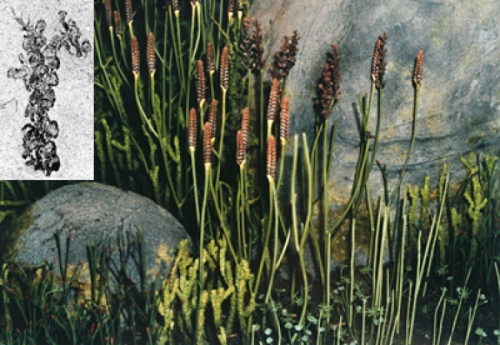Carolina scientists working with Canadian colleagues recently identified plant fossils dating back 420 million years. But the significance of their finding isn’t the fossils’ age — it’s their complexity.
About 800 miles from the North Pole in the Northwest Territories on Bathurst Island, James Basinger, professor of geology at the University of Saskatchewan, came across the fossils in 1994. He immediately called Patricia Gensel, professor of biology at UNC-Chapel Hill, because she has studied plants from the Devonian Period (363 to 409 million years ago).
The two researchers, along with Carolina graduate student Michele Kotyk, collected samples from rocky sediments on exposed slopes of the island near a site called Polar Bear Pass. Even though they were digging in July, most of the land was still covered in ice. “It was like going back in time,” Gensel says, “because the land was very barren — brown with a green sheen.”
What’s interesting, Gensel explains, is that when these plants were alive, they were actually growing in a much warmer climate. “Knowing the Earth’s magnetic orientation and the way the continents moved around, we were able to determine that these plants grew on land masses near the equator in warm, perhaps dry, climates,” Gensel says.
With the help of Canadian geologist Tim De Freitas and Basinger, Gensel and Kotyk dated the plants by examining small invertebrate fossils that were preserved along with the plant fossils. Looking through a microscope, they found evidence of graptolites and conodonts. The graptolite fossils resemble band saw blades, and the conodont fossils resemble miniature jaws and teeth — the mouthparts of primitive vertebrates.
“Invertebrates, and the conodonts, are much more indicative of age than plants,” Gensel says. “Because of them, we were able to determine that these plants were actually from the Silurian Period (420 million years ago) rather than the Devonian Period. While they are not the earliest vascular plants ever found, they are the earliest found of this size, complexity, and degree of diversification.”
Gensel described the plants as similar to, but a little larger than, mosses growing today. “They were four or more inches tall with many branches and rows of sporangia (cases of spores), and they probably grew in clusters,” she says.
“Finding this complexity of plants is exciting,” Gensel says. “It helps us better understand the timing of plant evolution.”
Catherine House was formerly a staff contributor for Endeavors.
This research was published in the June 2002 issue of the American Journal of Botany.


